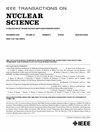Radiological Source Term Estimation and Isotopic Identification With Parallel Log Domain Particle Filters
IF 1.9
3区 工程技术
Q3 ENGINEERING, ELECTRICAL & ELECTRONIC
引用次数: 0
Abstract
This article presents a parallel log-domain particle filtering algorithm combined with gamma spectrum unfolding to perform localization, identification, and evaluation of multiple point sources of various isotopes in an environment with attenuating obstacles. The method uses sets of precomputed attenuation kernels that map the attenuation characteristics of the environment. These kernels are specific to the energy level of a photopeak of interest. The spectral measurements are deconvolved into count measurements of each photopeak. These count measurements are fed into a set of parallel particle filters using attenuation kernels computed for that photopeak’s energy level. The individual regularized particle filters perform all likelihood calculations in the logarithmic domain to mitigate the effects of particle degeneracy. The output of each particle filter is combined to estimate which isotopes are present as well as their positions and strengths. The performance of the algorithm is characterized in a lab-scale environment using a mobile robot equipped with a gamma ray spectrometer in the presence of up to three different radioactive isotopes simultaneously. The sources were localized to within 10 cm, and their strengths were estimated within 10% of their true values. The isotopes were all correctly identified, and no spurious sources were reported.利用并行对数域粒子滤波器进行放射源项估算和同位素鉴定
本文介绍了一种并行对数域粒子滤波算法,该算法与伽马频谱展开相结合,可在有衰减障碍物的环境中对各种同位素的多个点源进行定位、识别和评估。该方法使用一组预先计算的衰减核,映射环境的衰减特征。这些内核是针对相关光斑的能级而设计的。光谱测量结果解卷积为每个光斑的计数测量结果。这些计数测量值被送入一组并行粒子滤波器,该滤波器使用针对光斑能级计算的衰减核。各个正则化粒子滤波器在对数域中执行所有似然计算,以减轻粒子退化的影响。结合每个粒子滤波器的输出结果,可以估算出存在哪些同位素以及它们的位置和强度。在实验室规模的环境中,使用配备了伽马射线光谱仪的移动机器人,在多达三种不同放射性同位素同时存在的情况下,对该算法的性能进行了鉴定。放射源的定位精度在 10 厘米以内,其强度估计值不超过真实值的 10%。所有同位素都被正确识别,没有虚假源的报告。
本文章由计算机程序翻译,如有差异,请以英文原文为准。
求助全文
约1分钟内获得全文
求助全文
来源期刊

IEEE Transactions on Nuclear Science
工程技术-工程:电子与电气
CiteScore
3.70
自引率
27.80%
发文量
314
审稿时长
6.2 months
期刊介绍:
The IEEE Transactions on Nuclear Science is a publication of the IEEE Nuclear and Plasma Sciences Society. It is viewed as the primary source of technical information in many of the areas it covers. As judged by JCR impact factor, TNS consistently ranks in the top five journals in the category of Nuclear Science & Technology. It has one of the higher immediacy indices, indicating that the information it publishes is viewed as timely, and has a relatively long citation half-life, indicating that the published information also is viewed as valuable for a number of years.
The IEEE Transactions on Nuclear Science is published bimonthly. Its scope includes all aspects of the theory and application of nuclear science and engineering. It focuses on instrumentation for the detection and measurement of ionizing radiation; particle accelerators and their controls; nuclear medicine and its application; effects of radiation on materials, components, and systems; reactor instrumentation and controls; and measurement of radiation in space.
 求助内容:
求助内容: 应助结果提醒方式:
应助结果提醒方式:


